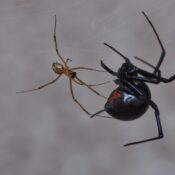As a child of about five, I began to view lawns with suspicion. It was 1970, and public-service TV spots were warning kids to stay away from “grass,” which was somehow bad for our health. Mom assured me this grass was different from the kind that grew in our yard. However, she seemed hesitant to give more details, which fueled my mistrust. So, I avoided grass for a time.
These days, “bread” is no longer money, and “mint!” has been supplanted by “awesome!” Cannabis is legal in much of North America, and grass is what grows in your lawn. Jargon may change, but unavoidable things like paying taxes and mowing lawns do not.
Garden centers stock a bewildering array of lawn-care products. It’s hard to know what’s right for your yard, and all too easy to spend a lot of dough – I mean money – on fertilizer, herbicide, grass seed, and grub control. I’d like to offer a few tips to help sort things out.
- Comparison spells trouble. Well, not really – they have different letters. But it’s unfair to compare. Quite often, people look to golf courses as examples of what a lawn should be. For billionaires, that’s no problem. In 2023, the average golf course will spend between $500,000 and a $1,000,000 on keeping their grass green. With only modest effort, though, the rest of us can still have a nice lawn at minimal cost.As Cornell turfgrass science researcher Dr. Frank Rossi writes in his Extension bulletin, “Lawn Care Without Pesticides,”
…you can grow a pretty good lawn without using insecticides, fungicides, or herbicides. You may even be able to do it using little or no chemical fertilizer, if that’s your goal. Will your lawn look like a putting green? No. But if you arm yourself with an understanding of what grasses need to thrive, …you can grow a perfectly acceptable lawn.
- The single best thing you can give your lawn is more of its hair. Grass blades are solar panels that feed the roots and keep your lawn healthy. A close-cropped lawn leads to weak, stunted plants that are susceptible to diseases and grub damage. It also gives low-growing weeds like ground ivy a tremendous advantage over your grass. Studies show that mowing at 3.5 to 4 inches high will greatly reduce lawn disease, grub damage, and fertilizer requirements. The most dramatic change with longer grass is a permanent drop in weed population.
- Mow no more than a third of the grass height. For example, to maintain a 3.5-inch turf height, mow when the grass gets five inches high. And keep your mower blades sharp. This helps reduce disease, looks nicer, and saves on gas. Also, mow when it’s dry. Mowing wet grass spreads disease.
- Grass clippings belong on the lawn, not in the landfill. Leave the clippings: they’re your fertilizer. If you’re mowing a third of the grass height at a time, clippings should never be a problem. If you’ve been away and are faced with a jungle of a lawn, you may have to remove any wads of cut grass.
- Nature abhors a vacuum (which is why I keep mine hidden away indoors – no sense offending nature if you can avoid it). Bare soil is a type of vacuum that nature wants to fill with whatever’s handy – usually, it’s weeds. Edging along sidewalks or driveways typically leaves a strip of bare earth. If you have a weed issue, especially crabgrass, trim next to walks, rather than edge.
- Peek under the hood of the lawn to get the dirt on your soil. We tend to assume weak-looking grass needs fertilizer, but this isn’t always the case. A basic place to start is soil pH, which tells you how acidic or basic (alkaline) the soil is. Plants do best in the neutral zone between pH 6.5 and 7.0. When values are below 6.0 or above 7.5, plants’ ability to absorb nutrients is curtailed. Most Extension offices offer soil pH tests, either for free or at nominal cost.
- Root out the urge to spread lime (calcium carbonate) each year. Over time, this raises soil pH to the point that grass cannot thrive.
- Invest in a soil test every 3-5 years, and only fertilize based on lab results. For under $20 you can get micro- and macro-nutrient levels with specific recommendations, plus pH. Your local Extension office can help you find a lab, and may even arrange free shipping for your sample.
- Only apply nitrogen in the fall. Spring applications give a boost of green, but at the expense of grass vigor.
- White grubs are only a problem if there are more than ten per square foot of lawn. Many things can result in patches of dead grass. Peel back the sod on a few square-foot test plots and count the grubs. If treatment is called for, several nontoxic and low-toxicity treatments have come on the market in the past few years, but timing varies widely for all of them, so read the label.
There are many solid lawn-care resources out there, but always check the source, which should be from .edu or .gov sites only. I highly recommend a free Cornell book entitled Lawn Care: The Easiest Steps to an Attractive Environmental Asset.
I think it would be great if we could teach kids to stay grounded, and let the grass get high.
Become a Saturday Evening Post member and enjoy unlimited access. Subscribe now



